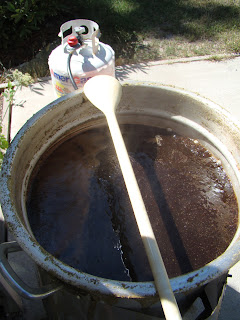Saison is a very loose style, varying greatly in strength, colour, spicing, level of funkiness, etc. I’d originally planned a big, burly saison noire with wintry spices, based on a Zymurgy article from a couple years back, for the early part of this year; when the yeast starter didn’t take off, switching to dry yeast, ditching the spices, and changing the hopping schedule transformed it into a tongue-flaying black IPA. I’ll come back to that
high-octane saison sometime; being in a session mood, and having plans for the yeast following this batch, I scaled it back to table strength for this winter.
“Holiday spices” (cloves, ginger, allspice, nutmeg) have rarely agreed with me in beer, though there have been notable exceptions. However, I’ve added a number of other non-Reinheitsgebot elements to beer before, including fruit, chocolate, cacao nibs, and vanilla and coffee beans. Branching out ever so slightly, this batch will get a cinnamon stick as well as a couple vanilla beans. My normal method for adding spices like these is to make a tincture and add the spices and liquid to secondary; I’ve tried adding them at the end of the boil, but haven’t felt as though they really came through very well. My spices here have been marinating in a small amount of vodka for the best part of a week, I’ll hopefully be able to transfer this beer onto them in the next couple days.
My go-to saison yeast is Wyeast’s French Saison (3711), but unfortunately my LHBS was out; they recommended the White Labs Platinum strain Belgian Saison II (566) as their closest sub. The plan was to use this low-gravity batch as a yeast starter for a Belgian dark strong ale I’m planning for next month; the last BDSA I brewed (with a cake of Wyeast 3787) finished out at a miserable 1.050, so I was anxious to see what the 3711, a ferocious attenuator in my experience, would do to a really big beer. The ester profile of this saison de la table will determine whether I forge ahead using this yeast cake or track down a fresh smack pack and get a normal starter on the stirplate.
Especially with the spices, this small beer didn’t need too many other flavours competing for dominance. Munich provided a malty base, with a bit of rye to add a touch of body; along with darkening the beer, the Carafa and Special B added a light roast and a little dark fruit character, respectively. The brew went into the wee hours of the morning; especially at that hour, the weather's finally starting to get crisp. I’m hoping this will be a lighter cold-weather alternative to the bigger, boozier beers I’ll brew this season. It also has me feeling adventurous enough to consider doing another sessionable batch with some of those “pumpkin pie” spices that normally give me pause, to serve at Thanksgiving and Christmas.
Petite Hiver - a petite saison noire spiced for winter
Batch size: 4.75 gallons
Projected OG: 1.040
Projected SRM: 25.7
Projected IBU: 14.9
Boil time: 60 minutes
Brewhouse efficiency: 80%
Grains
69.0% - 5 lb Munich
13.8% - 1 lb Rye
6.9% - 8 oz Organic Carafa II
 3.4% - 4 oz Special B
3.4% - 4 oz Special BHops
.5 oz Northdown (7.2%) (60 min)
Yeast
1 vial WLP566 Belgian Saison II (no starter)
Extras
1 Cinnamon stick, soaked in vodka (secondary)
2 Vanilla beans, chopped and scraped, soaked in vodka (secondary)
Water additions (mash)
4 qts RO water
Brewday: 2 October 2011
Mash-in: 150F for 60 minutes
Pre-boil volume: 6.25 gallons
Fermented at ambient temp (67F) for 3 days, then ramped up to 80F over 3 days
Secondary: 22 October 2011
Bottled: 12 November 2011
FG: 1.010
ABV: 3.9% - UT street legal success!
Bottled with 4.6 oz table sugar












